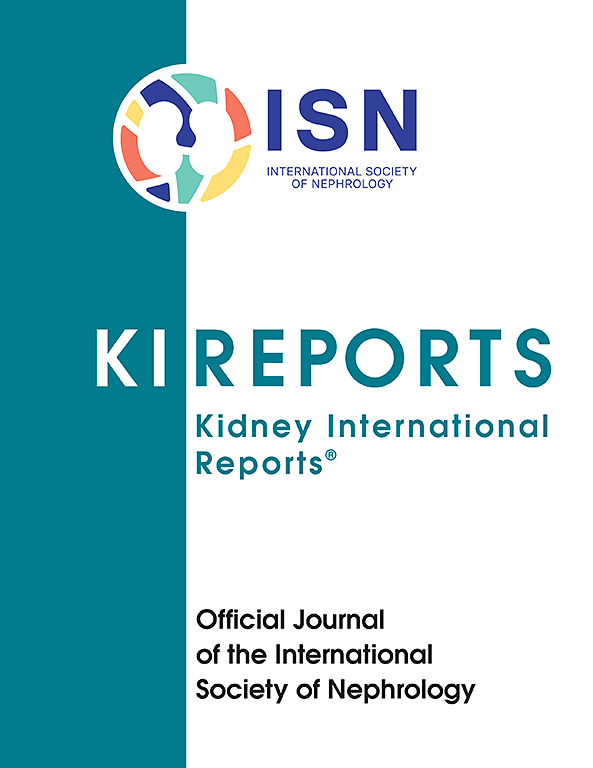COL4A5-p.Gly624Asp is the Predominant Variant in Europe Associated With a Mild Alport Syndrome Phenotype
IF 5.7
2区 医学
Q1 UROLOGY & NEPHROLOGY
引用次数: 0
Abstract
Introduction
Pathogenic variants in COL4A3–5 are common causes of inherited kidney disease. The clinical presentation extends from classical Alport syndrome (AS) to focal segmental glomerulosclerosis (FSGS) without extrarenal manifestation. In this study, we aimed to assess the genetic and phenotypic spectrum, along with the associated natural histories, in a cohort of patients with AS from 3 tertiary centers in Central Europe.
Methods
A total of 210 patients with disease causing variants in one of the COL4A3–5 genes were characterized and evaluated for genotype-phenotype correlations. In addition, 48 COL4A5-p.Gly624Asp carriers were analyzed for replication and pooled analysis.
Results
COL4A5-p.Gly624Asp was by far the most common variant, accounting for 16% of all genetic diagnoses. These patients presented with overall milder renal phenotypes than patients with other COL4A5 missense variants and COL4A5 glycine-missense variants after age- and sex-matching. In patients lacking a wild-type allele (X-Linked AS [XLAS] males and autosomal recessive AS [ARAS]), histological AS was most frequently observed in kidney biopsies, and truncating variants were associated with increased disease severity. Conversely, in patients with a wild-type allele present (XLAS females and autosomal dominant AS [ADAS]), FSGS was more frequently observed. Predicted protein truncation was not inferior to missense alterations in terms of renal survival.
Conclusion
The predominance of the European COL4A5 founder variant p.Gly624Asp allowed for the creation of the largest cohort of patients with an identical Alport variant to date, confirming the more favorable renal prognosis specific to this amino acid change. Allelic and gene dosage effects drive phenotypic differences and should be incorporated into future risk models.

COL4A5-p。Gly624Asp是欧洲与轻度阿尔波特综合征表型相关的主要变异
COL4A3-5的致病变异是遗传性肾脏疾病的常见原因。临床表现从经典的Alport综合征(AS)到局灶性节段性肾小球硬化(FSGS),无肾外表现。在这项研究中,我们旨在评估来自中欧3个三级医疗中心的AS患者的遗传和表型谱,以及相关的自然病史。方法对210例COL4A3-5基因致病变异患者进行特征分析,并评估基因型与表型的相关性。此外,48 COL4A5-p。对Gly624Asp载体进行复制和汇总分析。Gly624Asp是迄今为止最常见的变异,占所有遗传诊断的16%。与其他COL4A5错义变异体和COL4A5甘氨酸错义变异体相比,这些患者在年龄和性别匹配后的肾脏表型总体较轻。在缺乏野生型等位基因的患者(x连锁AS [XLAS]男性和常染色体隐性AS [ARAS])中,组织学AS最常在肾脏活检中观察到,截短变异与疾病严重程度增加相关。相反,在存在野生型等位基因(XLAS女性和常染色体显性AS [ADAS])的患者中,FSGS更常见。在肾脏存活方面,预测的蛋白质截断并不亚于错义改变。结论欧洲COL4A5始祖变异p.Gly624Asp的优势使得迄今为止最大的具有相同Alport变异的患者队列的创建成为可能,证实了这种氨基酸变化特异性的更有利的肾脏预后。等位基因和基因剂量效应驱动表型差异,应纳入未来的风险模型。
本文章由计算机程序翻译,如有差异,请以英文原文为准。
求助全文
约1分钟内获得全文
求助全文
来源期刊

Kidney International Reports
Medicine-Nephrology
CiteScore
7.70
自引率
3.30%
发文量
1578
审稿时长
8 weeks
期刊介绍:
Kidney International Reports, an official journal of the International Society of Nephrology, is a peer-reviewed, open access journal devoted to the publication of leading research and developments related to kidney disease. With the primary aim of contributing to improved care of patients with kidney disease, the journal will publish original clinical and select translational articles and educational content related to the pathogenesis, evaluation and management of acute and chronic kidney disease, end stage renal disease (including transplantation), acid-base, fluid and electrolyte disturbances and hypertension. Of particular interest are submissions related to clinical trials, epidemiology, systematic reviews (including meta-analyses) and outcomes research. The journal will also provide a platform for wider dissemination of national and regional guidelines as well as consensus meeting reports.
 求助内容:
求助内容: 应助结果提醒方式:
应助结果提醒方式:


